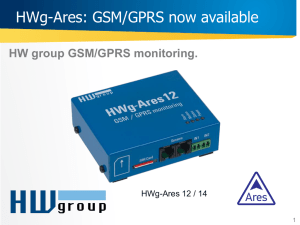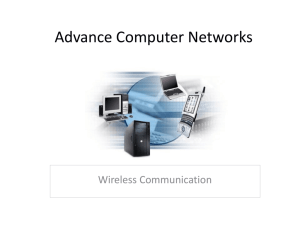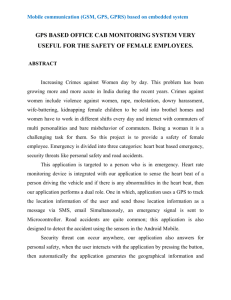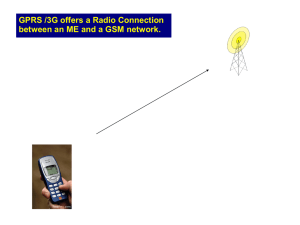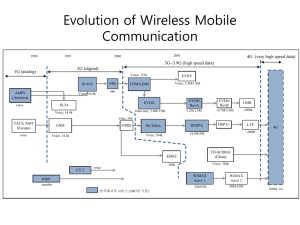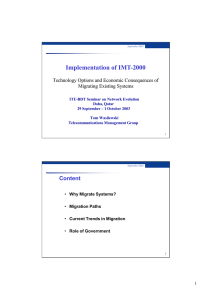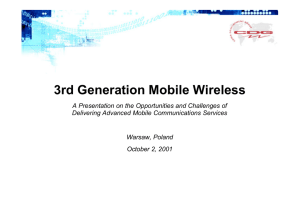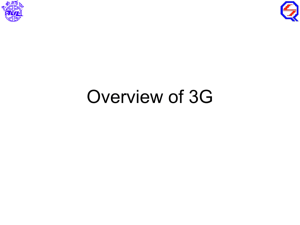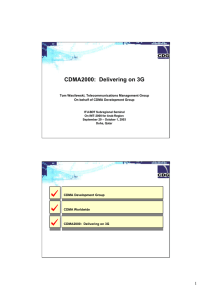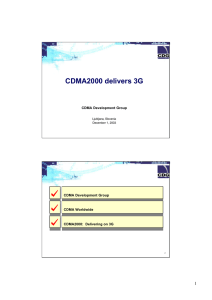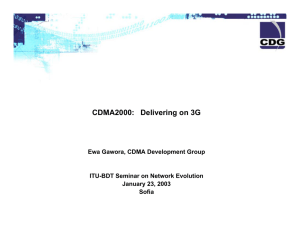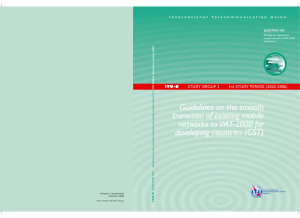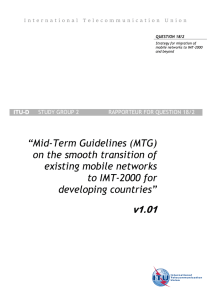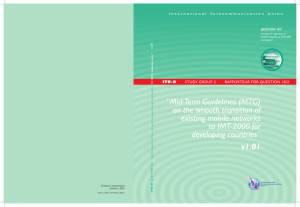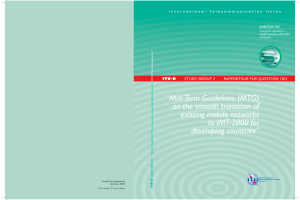Evolution of mobile wireless networks
advertisement
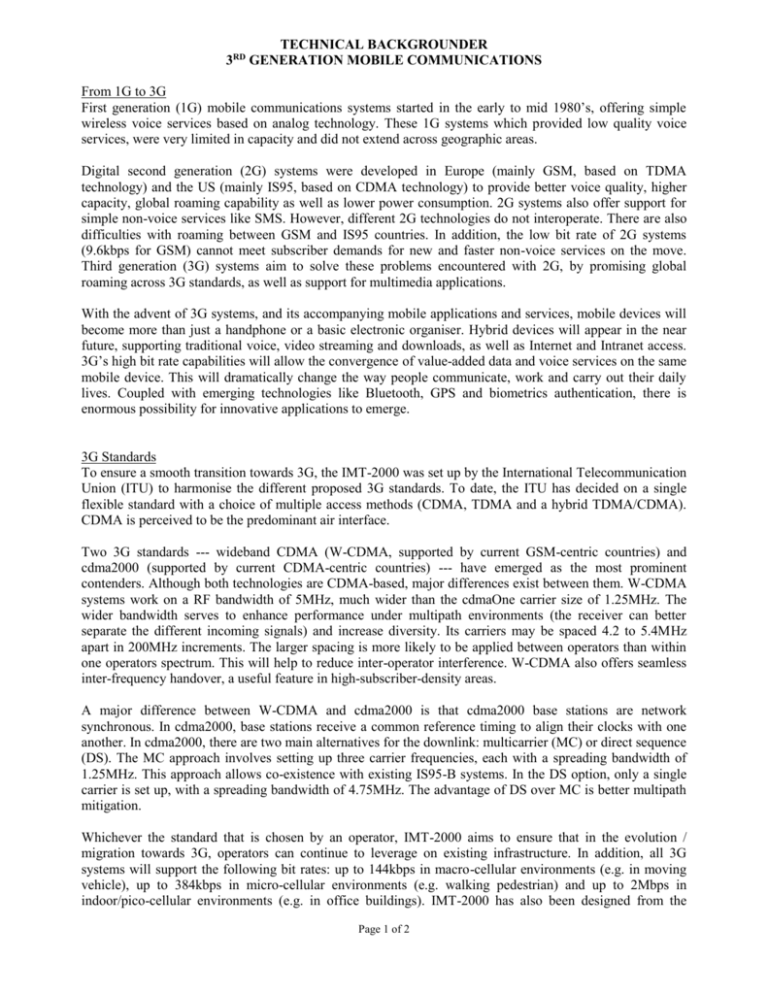
TECHNICAL BACKGROUNDER 3RD GENERATION MOBILE COMMUNICATIONS From 1G to 3G First generation (1G) mobile communications systems started in the early to mid 1980’s, offering simple wireless voice services based on analog technology. These 1G systems which provided low quality voice services, were very limited in capacity and did not extend across geographic areas. Digital second generation (2G) systems were developed in Europe (mainly GSM, based on TDMA technology) and the US (mainly IS95, based on CDMA technology) to provide better voice quality, higher capacity, global roaming capability as well as lower power consumption. 2G systems also offer support for simple non-voice services like SMS. However, different 2G technologies do not interoperate. There are also difficulties with roaming between GSM and IS95 countries. In addition, the low bit rate of 2G systems (9.6kbps for GSM) cannot meet subscriber demands for new and faster non-voice services on the move. Third generation (3G) systems aim to solve these problems encountered with 2G, by promising global roaming across 3G standards, as well as support for multimedia applications. With the advent of 3G systems, and its accompanying mobile applications and services, mobile devices will become more than just a handphone or a basic electronic organiser. Hybrid devices will appear in the near future, supporting traditional voice, video streaming and downloads, as well as Internet and Intranet access. 3G’s high bit rate capabilities will allow the convergence of value-added data and voice services on the same mobile device. This will dramatically change the way people communicate, work and carry out their daily lives. Coupled with emerging technologies like Bluetooth, GPS and biometrics authentication, there is enormous possibility for innovative applications to emerge. 3G Standards To ensure a smooth transition towards 3G, the IMT-2000 was set up by the International Telecommunication Union (ITU) to harmonise the different proposed 3G standards. To date, the ITU has decided on a single flexible standard with a choice of multiple access methods (CDMA, TDMA and a hybrid TDMA/CDMA). CDMA is perceived to be the predominant air interface. Two 3G standards --- wideband CDMA (W-CDMA, supported by current GSM-centric countries) and cdma2000 (supported by current CDMA-centric countries) --- have emerged as the most prominent contenders. Although both technologies are CDMA-based, major differences exist between them. W-CDMA systems work on a RF bandwidth of 5MHz, much wider than the cdmaOne carrier size of 1.25MHz. The wider bandwidth serves to enhance performance under multipath environments (the receiver can better separate the different incoming signals) and increase diversity. Its carriers may be spaced 4.2 to 5.4MHz apart in 200MHz increments. The larger spacing is more likely to be applied between operators than within one operators spectrum. This will help to reduce inter-operator interference. W-CDMA also offers seamless inter-frequency handover, a useful feature in high-subscriber-density areas. A major difference between W-CDMA and cdma2000 is that cdma2000 base stations are network synchronous. In cdma2000, base stations receive a common reference timing to align their clocks with one another. In cdma2000, there are two main alternatives for the downlink: multicarrier (MC) or direct sequence (DS). The MC approach involves setting up three carrier frequencies, each with a spreading bandwidth of 1.25MHz. This approach allows co-existence with existing IS95-B systems. In the DS option, only a single carrier is set up, with a spreading bandwidth of 4.75MHz. The advantage of DS over MC is better multipath mitigation. Whichever the standard that is chosen by an operator, IMT-2000 aims to ensure that in the evolution / migration towards 3G, operators can continue to leverage on existing infrastructure. In addition, all 3G systems will support the following bit rates: up to 144kbps in macro-cellular environments (e.g. in moving vehicle), up to 384kbps in micro-cellular environments (e.g. walking pedestrian) and up to 2Mbps in indoor/pico-cellular environments (e.g. in office buildings). IMT-2000 has also been designed from the Page 1 of 2 outset to link both terrestrial and satellite components, so that subscribers roaming between terrestrial and satellite networks can expect smooth communication. Migration to 3G In the evolution from 2G to 3G systems, different migration paths have been identified for GSM and CDMAcentric systems. The objective is to enhance spectral efficiency and network capacity. Mobile operators around the world will be migrating their networks towards 2.5G (e.g. General Packet Radio Service) or even 3G systems in the near future. Unlike 2G systems, 2.5G and 3G systems will feature packet-switched technology. Packet-switching means that dedicated circuits do not need to be established between communicating devices, and network resources are used only when actual data is transmitted. This means “always-on” connectivity for subscribers. Billing for 2.5G and 3G services could, in the future, be packetbased, time-based or a mixture of the two. GSM-centric operators have the option to implement General Packet Radio Service (GPRS) and/or Enhanced Data Rates for Global Evolution (EDGE) prior to 3G rollout. GPRS provides a relatively easy upgrade of existing 2G networks to support higher bit rates. Commonly considered a 2.5G technology, GPRS offers a theoretical maximum 171.2kbps bit rate, when all 8 time slots are utilised at once. However, it is more likely that subscribers would only be allocated 2-4 time slots, significantly lowering the actual bit rate. In addition, initial GPRS deployments would only provide point-to-point support, meaning that subscribers can only communicate with one party at any one time. At present, some European operators have announced commercial GPRS rollouts this year. GPRS roaming trials have also been conducted in Asia. Mobile data services are likely to take off with the advent of higher bit rates offered by GPRS. Beyond GPRS, operators have the option of implementing EDGE or migrating directly to W-CDMA. EDGE enhances GPRS and offers bit rates of up to 384kbps through the use of a more efficient modulation technique. Another advantage of EDGE over GPRS is support for point-to-multipoint communication. Operators without 3G licenses may be able to offer GPRS or EDGE instead. However, some operators may prefer a direct 3G implementation over additional infrastructure costs in association with EDGE. Also, a significant challenge facing GSM migration is handset compatibility. New handsets will be required for every migration step, GPRS, EDGE, as well as W-CDMA. For CDMA-centric networks, there are several technology choices for 3G migration. Generally, there are three potential high-speed technologies: cdma2000 3X, High Data Rate (HDR) and 1Xtreme. CDMA operators are likely to implement cdma2000 1X initially; and, subsequently either 3X, HDR or 1Xtreme. 1X (meaning that only a single 1.25MHz CDMA carrier is used) offers approximately twice the voice capacity of cdmaOne. It offers averages data rates of 144kbps and has backward compatibility with cdmaOne. The technology may also be implemented at other than cdmaOne frequencies. 3X offers even higher capacity, data rates of up to 2Mbps, as well as backward compatibility with 1X. HDR technology is another possible migration step competing with 3X. It is a data only overlay technology promising up to 2.4Mbps over a dedicated CDMA carrier. Lucent Technologies and Qualcomm Inc. are the two major proponents of HDR. 1Xtreme, another competing technology, supports voice and data traffic, and offers up to 5.2Mbps on a single carrier. This technology has the support of major handset vendors like Nokia and Motorola. Useful Websites www.umts-forum.org www.the3gportal.com www.itu.int/imt www.gsmworld.com/technology/3g_future.html www.3gpp2.org Page 2 of 2

